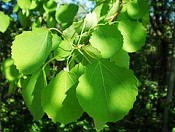populus

Populus is a genus of 25–35 species of deciduous flowering plants in the family Salicaceae, native to most of the Northern Hemisphere. English names variously applied to different species include poplar, aspen, and cottonwood. The genus has a large genetic diversity, and can grow from anywhere between 15–50 m tall, with trunks of up to 2.5 m diameter. The bark on young trees is smooth, white to greenish or dark grey, often with conspicuous lenticels; on old trees it remains smooth in some species, but becomes rough and deeply fissured in others. The shoots are stout, with (unlike in the related willows) the terminal bud present. The leaves are spirally arranged, and vary in shape from triangular to circular or (rarely) lobed, and with a long petiole; in species in the sections Populus and Aegiros, the petioles are laterally flattened, so that breezes easily cause the leaves to wobble back and forth, giving the whole tree a "twinkling" appearance in a breeze. Leaf size is very variable even on a single tree, typically with small leaves on side shoots, and very large leaves on strong-growing lead shoots. The leaves often turn bright gold to yellow before they fall during autumn.[1][2] The flowers are mostly dioecious (rarely monoecious) and appear in early spring before the leaves. They are borne in long, drooping, sessile or pedunculate catkins produced from buds formed in the axils of the leaves of the previous year. The flowers are each seated in a cup-shaped disk which is borne on the base of a scale which is itself attached to the rachis of the catkin. The scales are obovate, lobed and fringed, membranous, hairy or smooth, usually caducous. The male flowers are without calyx or corolla, and comprise a group of 4–60 stamens inserted on a disk; filaments short, pale yellow; anthers oblong, purple or red, introrse, two-celled; cells opening longitudinally. The female flower also has no calyx or corolla, and comprises a single-celled ovary seated in a cup-shaped disk. The style is short, with 2–4 stigmas, variously lobed, and numerous ovules. Pollination is by wind, with the female catkins lengthening considerably between pollination and maturity. The fruit is a two to four-valved capsule, green to reddish-brown, mature in mid summer, containing numerous minute light brown seeds surrounded by tufts of long, soft, white hairs which aid wind dispersal.[1][3] Poplars of the cottonwood section are often wetlands or riparian trees. The aspens are among the most important boreal broadleaf trees.[1] Poplars and aspens are important food plants for the larvae of a large number of Lepidoptera species - see List of Lepidoptera that feed on poplars. In the September 2006 issue of Science, it was announced that the Western Balsam Poplar (P. trichocarpa) was the first tree to have its full DNA code sequenced.[4] The genus Populus has traditionally been divided into six sections on the basis of leaf and flower characters;[2][5] this classification is followed below. Recent genetic studies have largely supported this, though showing that the relationships are somewhat more complex, with some reticulate evolution due to past hybridisation and introgression events between the groups; some species (noted below) had differing relationships indicated by their nuclear DNA (paternally inherited) and chloroplast DNA sequences (maternally inherited), a clear indication of likely hybrid origin.[6] Hybridisation continues to be common in the genus, with several hybrids between species in different sections known.[1] Many poplars are grown as ornamental trees, with numerous cultivars used. They have the advantage of growing very big, very fast. Almost all poplars take root readily from cuttings or where broken branches lie on the ground. Trees with fastigiate (erect, columnar) branching are particularly popular, and are widely grown across Europe and southwest Asia. However, like willows, poplars have very vigorous and invasive root systems stretching up to 40 m from the trees; planting close to houses or ceramic water pipes may result in damaged foundations and cracked walls and pipes due to their search for moisture. There is interest in using poplar as an energy crop for biomass or biofuel, in energy forestry systems, particularly in light of its high energy in-energy out ratio, large carbon mitigation potential and fast growth. In the United Kingdom poplar (as with fellow energy crop willow) is typically grown for two to five years (with single or multiple stems), then harvested and burned - the yield of some varieties can be as high as 12 oven dry tonnes every year[9] Poplar was the most common wood used in Italy for panel paintings; the Mona Lisa and indeed most famous early renaissance Italian paintings are on poplar. The wood is generally white, often with a slightly yellowish cast. Some stringed instruments are made with one-piece poplar backs; violas made in this fashion are said to have a particularly resonant tone. Lombardy Poplars are used as a wind barrier around agricultural fields to protect against wind erosion.
do you like this author?
What readers are saying
What do you think? Write your own comment on this book!
write a commentWhat readers are saying
What do you think? Write your own comment on this author!
write a commentBook list

A private citizen's proposal for the settlement of all differences between the northern and southern states
Series:
Unknown
Year:
Unknown
Raiting:
3.5/5
Show more
add to favoritesadd In favorites

a private citizens proposal for the settlement of all differences between the n
Series:
Unknown
Year:
Unknown
Raiting:
4/5
Show more
add to favoritesadd In favorites
Book list

A private citizen's proposal for the settlement of all differences between the northern and southern states
Series:
Unknown
Year:
Unknown
Raiting:
3.5/5
Show more
add to favoritesadd In favorites

a private citizens proposal for the settlement of all differences between the n
Series:
Unknown
Year:
Unknown
Raiting:
4/5
Show more
add to favoritesadd In favorites
What readers are saying
What do you think? Write your own comment on this author!
write a commentif you like populus try:
readers also enjoyed
What readers are saying
What do you think? Write your own comment on this author!
write a commentif you like populus try:
readers also enjoyed
Do you want to exchange books? It’s EASY!
Get registered and find other users who want to give their favourite books to good hands!

